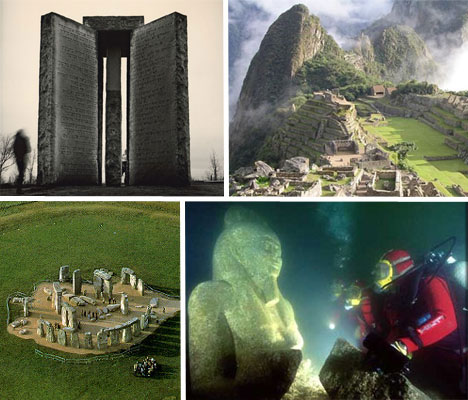
Monumental Instructions for the Post-Apocalypse
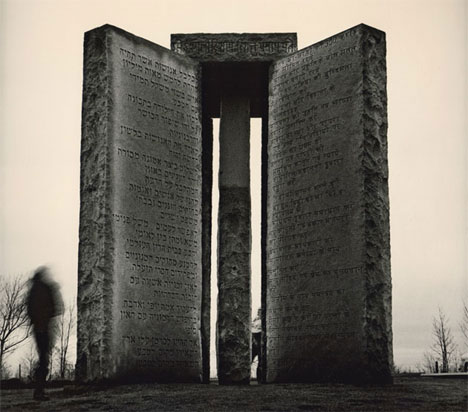
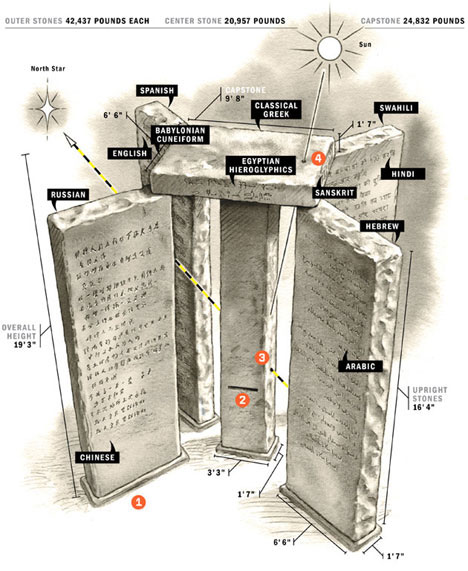
(images via: Wired)
On a barren knoll in northeastern Georgia stands one of the world’s most bizarre and mysterious monuments. But it wasn’t created during ancient times. Known as the ‘Georgia Guidestones’, this stone structure of five 16-feet-tall, 20-ton slabs of polished granite is inscribed in eight languages – including Egyptian Hieroglyphics, Hindi and Swahili – with instructions for dazed post-apocalyptic survivors attempting to rebuild civilization. It’s oriented to track the sun’s east-west migration year-round, and has holes that allow gazers to locate the North Star. The Georgia Guidestones were commissioned by an anonymous group, whose identity remains a mystery.
Lake Michigan Stonehenge
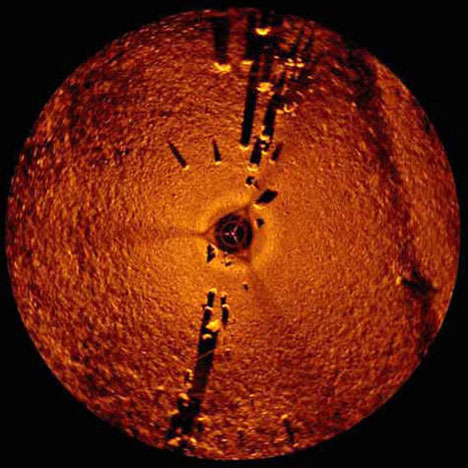
(image via: io9)
A group of researchers using sonar to look for shipwrecks at the bottom of Lake Michigan got quite a surprise when they found what appears to be an ancient Stonehenge-like structure 40 feet beneath the surface of the water. Some of the stones are arranged in a circle and one appears to show carvings of a mastodon. The formation could be as much as 10,000 years old, which is coincident with the post-Ice Age presence of both humans and mastodons in the area. Michigan already has petroglyph sites and standing stones.
Underwater Ruins in Japan
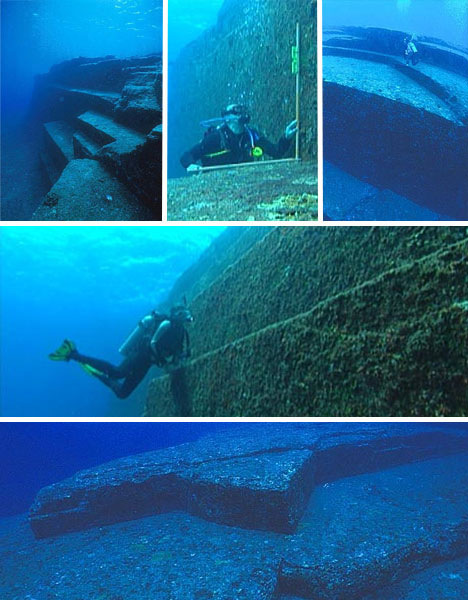
(images via: Hottnez)
On the southern coast of Yonaguni, Japan, lie submerged ruins estimated to be around 8,000 years old. Though some people believed that it was carved by geographic phenomena, it’s now confirmed to be man-made as the intricate stairways, carvings and right angles suggest. It was discovered in 1995 by a sport diver who strayed too far off the Okinawa shore with a camera in hand.
Submerged Wonders of Alexandria, Egypt

(images via: WebUrbanist)
From WebUrbanist: “Off the shores of Alexandria, the city of Alexander the Great, lie what are believed to be the ruins of the royal quarters of Cleopatra. It is believed that earthquakes over 1,500 years ago were responsible for casting this into the sea, along with artifacts, statues and other parts of Cleopatra’s palace. The city of Alexandria even plans to offer underwater tours of this wonder.”
The Mysterious Stones of Baalbek

(images via: National Geographic)
The largest Roman temple ever constructed stands in ruins not in Greece or Rome, but in Baalbek, Lebanon. The temple was destroyed under Byzantine Emperor Theodosius but 6 of its original 54 columns still stand. Despite their beauty, the ruins at Baalbek have rarely been visited during recent decades due to war, but luckily this majestic archeological site has escaped harm. No one knows what made this site so special to the Romans, prompting them to quarry, move and assemble so many stone blocks.
Three Buried Ancient Megalithic Stone Circles
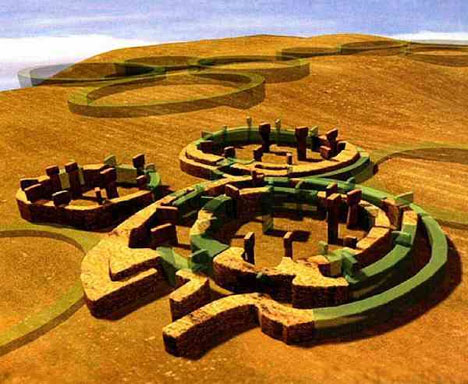
(images via: Environmental Graffiti)
In southern Turkey, just north of the border with Syria, are three megalithic stone circles several thousand years older than the “first” stone circle built at Stonehenge. Strangely, these ancient stone circles were built by a hunter-gatherer society. It had previously been believed that the workforce required to construct a megalithic stone circle couldn’t be organized until human society reached the village stage of development. The three stone circles at Göbekli Tepe were deliberately buried for reasons unknown. Some people believe that Göbekli Tepe and the surrounding region were the historical basis behind the biblical Garden of Eden.
Easter Island
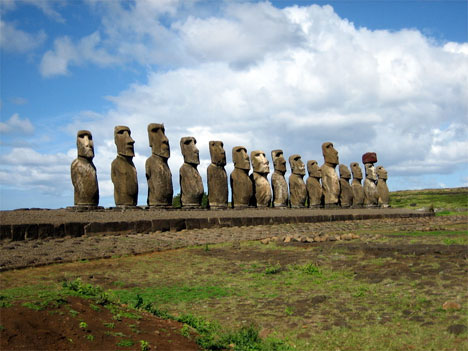
(images via: Wikipedia)
Easter Island, also known as Rapa Nui or Isla de Pascua, is a Polynesian island in the southeastern Pacific Ocean, most famous for its monumental statues which were created by the Rapanui people. The statues, called moai, were part of the ancestral worship of the island’s settlers and were carved between 1250 and 1500 CE. The heaviest moai erected weighs 86 tons, illustrating how great a feat it was for the Rapanui to have created and moved them. Nearly half of all remaining moai are still at Rano Raraku, the main moai quarry, but hundreds were moved to stone platforms around the island’s perimeter.
Stonehenge

(image via: witcombe.sbc.edu)
Perhaps the world’s best known monument is Stonehenge, located in the English county of Wiltshire. It’s composed of earthworks surrounding a circular setting of large standing stones and is believed to have been built around 2500 BC but has been revised and remodeled over a period of more than 1400 years. Though theories and speculation abound, no one knows what the original purpose of the prehistoric monument was and it remains one of the earth’s greatest mysteries.
Machu Picchu

(images via: Rediscover Machu Picchu)
Machu Picchu is the most well-preserved city of the Inca empire, hidden in the Peruvian Andes high on a steep mountain with a flattened top, a location that helped it escape notice by Spanish conquistadors. It was forgotten for centuries by the outside world, and re-discovered by archeologist Hiram Bingham in 1911. The stones of this city fit together so tightly a knife blade can’t fit between them. Modern research suggests that Machu Picchu was built around 1450 CE as a retreat by and for the Inca ruler Pachacuti and that it was actually relatively small by Inca standards.
Great Zimbabwe Ruins
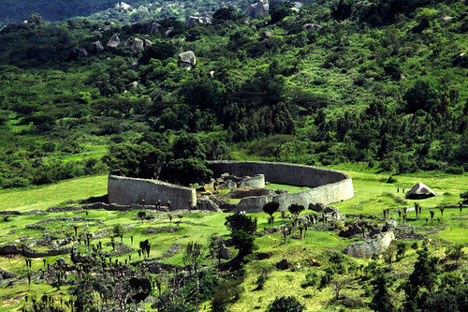
(images via: 10-us)
Few people know that the modern-day African country of Zimbabwe was actually named after stone ruins that lie all over the countryside. The ‘Great Zimbabwe Ruins’ are some of the oldest and largest structures located in Southern Africa and at its peak, the ruins of Great Zimbabwe are estimated to have housed as many as 18,000 inhabitants. The Great Zimbabwe ruins span 1,800 acres and were constructed starting in the 11th century without the use for mortar. No one knows for sure why the site was eventually abandoned.
Peru’s Chavín de Huantar Ruins
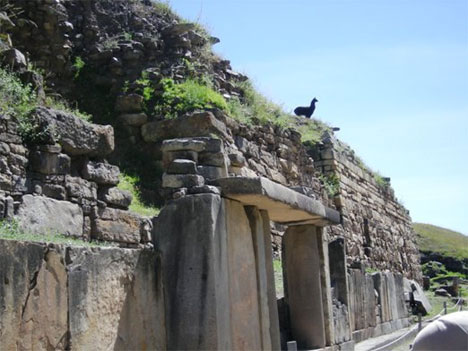
(images via: EcoWorldly)
While not as famous as the ruins at Machu Picchu, the Chavín de Huantar Ruins of Peru are also a fascinating World Heritage Site containing ruins and artifacts originally constructed by the Chavín, a pre-Inca culture, around 900 BC. The site served as a gathering place for people in the area to assemble and worship. It’s unclear why the Chavín culture disappeared, though some believe that the Chavín de Huantar ruins offer clues as to why some civilizations vanish. Most theories about the Chavín center on difficult environmental conditions including earthquakes, while others involve power struggles with other civilizations in the same region.
Coral Castle, Monument to Lost Love

(images via: ABC news)
How did one five-foot-tall, 100-pound man build an intricate rock garden using pieces of coral that weighed several tons each? Coral Castle, in Homestead, Florida, was Latvian immigrant Ed Leedskalnin’s monument to a lost love. He began building it in 1923 after being jilted by his fiance in Latvia just days before their wedding, and dedicated his life to completing it. Construction continued even after his death in 1951. Experts are puzzled as to how Leedskalnin, who had only a fourth-grade education, could have built Coral Castle by himself. One engineer claims that even Albert Einstein couldn’t figure it out.
No comments:
Post a Comment